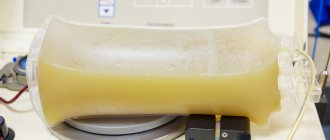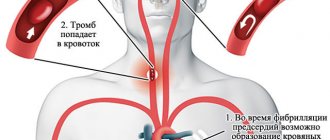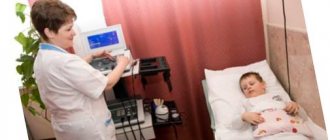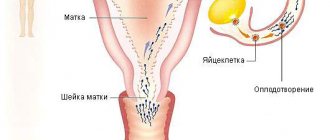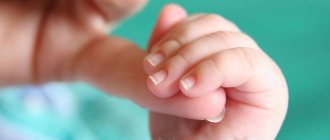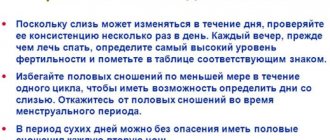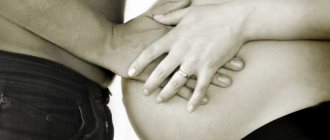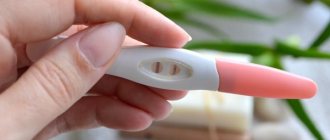While expecting a child, many mothers try to learn as much as possible about pregnancy and childbirth, believing that the most difficult thing is giving life to a new person. In movies, everything ends with a wedding, but in life, everything just begins with a wedding. It’s the same with motherhood: with the birth of a child, the fun begins. A young mother needs to accomplish so much in a day! And here it is important to properly distribute your time and energy. We will tell you about how to properly organize care for a newborn girl, what to pay attention to, in which cases to seek qualified help, and in which cases not to panic and just wait for time. This information will be useful not only to mothers of first-borns, but also to those who have their first baby in the family.
In the first days
During the first time after birth, a light gray or creamy coating - remnants of smegma, the original lubricant. If there is not a lot of plaque, it will gradually be absorbed into the skin. However, if the plaque is abundant, it is recommended to remove it, since after a day or two the fats it contains oxidize, causing the proliferation of microorganisms and, ultimately, inflammation. This plaque is quite dense, so it needs to be removed delicately, in several steps. It is best to use cotton swabs and warm boiled water for this. The plaque will be removed in pellets and will completely disappear in 2-3 days.
Features of girls' intimate hygiene
The skin of the genital organs of newborn girls is very thin and delicate. Any aggressive impact can lead to irritation and inflammatory processes, causing pain and discomfort to the baby.
Prolonged contact with urine (when the baby is in a diaper for a long time) negatively affects the condition of the skin - it turns red, diaper rash and signs of irritation appear. To prevent this from happening, it is important to change the diaper frequently, wash the baby after each diaper change and provide air baths for at least 10-15 minutes.
Any crack (even the smallest) on the genitals is a direct path to the penetration of bacteria and microbes into the vagina, so intimate care is important as a prevention of infectious diseases.
Regular washing, performed according to the rules, promotes the formation of beneficial vaginal microflora and protects the girl from infections and diseases of the genital organs in the future.
Girls whose parents did not pay enough attention to genital hygiene during infancy are more likely to suffer from vaginitis, vaginal dysbiosis, vulvitis and other pathologies of the genital area.
How to properly wash a newborn baby girl
The girl needs to be washed every time she changes her diaper, and simple wiping with wet wipes is unacceptable here. You can remove feces with napkins, after which you should definitely rinse the perineum under running water. Mom, of course, needs to wash her hands with soap before doing this. In the first months of life, it is advisable to rinse a girl’s genitals in the direction of the anus, so that feces particles do not enter the vagina and cause inflammation. For the same reasons, it is impossible to wash the girl in the basin after defecation. Older girls are washed as follows: first, they soap and rinse the anal area (from the bottom up, towards the tailbone; a stream of water is directed into the palm), then they wash their hands again and wash the external genitalia without soap (from the perineum to the pubis, without touching the anus ).
| This is important to know! Your excessive attachment to cleanliness may come back to haunt your daughter with synechiae - partial fusion of the labia minora, which most often occurs due to the fact that soap injures the thin mucous membrane of the girl’s genitals and causes an inflammatory process. |
Caring for a newborn girl after washing is performed in the following sequence: first, blot the genital area dry with a clean towel, then the labia and the skin around them, the inguinal folds, and only then the anus area. At this age, the skin and mucous membranes are dry and easily wounded, so they must be moisturized with baby cream or sterilized vegetable oil. Never wipe the inside of the labia, as this can disrupt the vaginal microflora and lead to genitourinary infections.
| This is important to know! On days 4–7 of life, a newborn daughter may experience mucous-bloody discharge from the vagina. This is how the hormones she received from you make themselves known. This phenomenon is called neonatal hormonal crisis , does not require treatment and goes away on its own within a few days. However, if the genitals are red, and the vaginal discharge is purulent and has an unpleasant odor, contact your pediatrician immediately! With the exception of a hormonal crisis, girls of this age should not normally have vaginal discharge. If any discharge appears, contact your pediatrician (pediatrician or pediatric gynecologist) without delay. |
What to expect in the maternity hospital
In addition to positive emotions and frantic fatigue, a woman faces a lot of worries in caring for her newborn baby. Experienced mothers recommend getting involved in this process already in the maternity hospital. Here you can ask the medical staff for advice, here they will show you how to wash your baby, put on a diaper, swaddle her, and put her to her breast. If these skills are not developed, you will have to master this science on your own at home. Often mothers who have given birth to their first child experience uncertainty and fear that they might do something wrong or harm the baby. However, a week or two passes and everything gets better.
Breast care
A few days after birth, a girl may experience swelling and redness of the mammary glands , sometimes accompanied by the release of colostrum. This is also a hormonal phenomenon. Do not massage your baby’s breasts or try to squeeze out the contents of the mammary glands; avoid rubbing this area on clothing – and in 2-3 weeks everything will go away on its own. If redness and enlargement of the mammary glands are too pronounced, consult your pediatrician.
What products should I use for washing?
For the hygienic cleansing of the genitals of babies, many safe products are produced that do not contain dyes, artificial additives and components harmful to the skin.
Doctors' recommendations regarding what to wash a girl in her first year of life are the same: only baby soap or a special soft gel for washing babies. They should be used in cases where the child has had a bowel movement; in all other situations, running water is the best way to keep the baby’s genitals clean.
If the skin has inflammation or signs of irritation (rash, redness), you can use decoctions of anti-inflammatory herbs with a calming effect: chamomile, calendula, sage. They will help eliminate unpleasant symptoms and soften thin skin.
Decoctions of medicinal herbs can be added to water while bathing. If you don’t have the time or desire to prepare them yourself, you can buy ready-made formulations at the pharmacy, for example, herbs for bathing in the form of “Our Mother” decoction.
To wash girls, it is not allowed to use products intended for the intimate hygiene of adult women, as well as regular soap, as they disrupt the normal acidity level of the vagina and dry out the skin, destroying beneficial microflora.
Bathing
- You can bathe a newborn girl as soon as the umbilical wound dries. Up to six months, baths should be daily, then you can bathe the baby every other day, and when she reaches a year, even less often, replacing bath procedures with showers.
- You should carefully wash all the folds and spaces between your fingers and toes.
- It is recommended to use soap (not toilet soap, but a special one for children, with a minimum amount of additives!) or baby foam no more than 1-2 times a week, and do not add it to water, but apply it to the skin and wash it off with a shower. Soapy water dries out the vaginal mucosa. There is an opinion that until the moment the child begins to crawl on the floor (i.e., until the moment when he can really get dirty) or until the moment when the baby begins to eat complementary foods (i.e., smearing porridge on his face with his hands or puree) - there is no point in washing it with soap, because the child does not get dirty with anything and is constantly either in the arms of his parents or in a clean crib. And once again disturbing his skin with soap products is not only pointless, but also harmful - the protective layer of the skin is washed off. But, firstly, daily bathing in clean water is still necessary, and secondly, this does not exclude washing the child with soap after he pooped.
- Adding various herbal infusions to the bath is at your discretion. However, it must be borne in mind that almost all of them dry out the already dry skin of babies. At the end of winter and spring in cities, an increased amount of chlorine is added to the central water supply, which greatly dries out the skin of children during daily bathing. In this case, it is recommended to add special softeners to the bathing water, for example, calendula bathing agent (Weleda has this). And after bathing, lubricate the baby’s skin with baby oil.
- A newborn girl should use her own, purely individual, bathing set: towel, washcloth and mitten. By the way, you can wash the baby with a piece of gauze instead of a washcloth, since it can be washed and boiled.
- After bathing, the newborn girl is blotted dry with a clean towel or warm sheet, and the skin folds, if necessary, are treated with baby hygienic oil.
Prevention: 5 important points
Caring for newborn girls is not difficult if simple washing rules and preventive measures are followed.
- Ventilation after hygiene procedures. This is a prerequisite for protecting delicate skin from diaper rash. First, the newborn can take air baths for 5 minutes. Over time, you can increase them to 15–20 minutes. At the same time, the air temperature in the room should be comfortable so that the baby does not freeze.
- Comfortable water temperature. It should not be too hot or, conversely, cold. In the first month, when washing, the water should be warmer, then gradually the temperature can be reduced, especially in the hot season.
- Correct support when washing. Lay the girl with her back on her left forearm so that her head is in the crook of her elbow. Press it to your body, be sure to hold the baby by one thigh, and wash it with your right hand. At first, it is not entirely convenient to wash the child alone. It's good if there is an assistant nearby.
- Use boiled water. This condition must be met only in the first two weeks of life. Then you can safely wash the baby under running water from a regular tap. Take care of the cleanliness and quality of your water in advance by installing purification filters.
- Use your own towel. Provide a separate towel for intimate hygiene. First you need to wipe the perineum, and then the butt. The movements should be delicate and blotting. You cannot wipe the inside of the labia, this leads to dryness of the vaginal mucosa and disrupts its natural microflora.
Don't overuse wet wipes. It is still better to perform intimate hygiene under running water. Napkins can be used in emergency situations: while walking, traveling, at the dacha. The child may be allergic to them.
Ear care
Contrary to popular belief, sulfur is not dirt, but a means of protecting the body. It has bactericidal properties and protects the ear canal from drying out, dust, wind and water. Therefore, do not be zealous in removing it. The maximum that is allowed is to carefully remove with a cotton wool the wax that is in the visible zone, that is, it has come out of the ear canal into the auricle. Each ear has a separate flagellum. Do not use cotton swabs under any circumstances, do not penetrate the swab into the ear canal - this can lead to the pushing of sulfur deeper and the formation of cerumen plugs.
During bathing, the ears are carefully washed with water. If water gets into them, simply blot your ears with a towel. The main thing is to make sure that there are no drafts in the room.
The skin behind the ears requires special attention. Rinse it during bathing and lubricate it with baby oil, especially if there are crusts. Decoctions of skin-soothing herbs and creams with zinc oxide help with diaper rash.
| This is important to know! If erosion occurs at the site of diaper rash, be sure to consult your pediatrician. Incorrect treatment in this case can result in unpleasant consequences for the baby. |
Fusion of the labia
Another topic that is discussed so often on mom forums. There is a strong opinion floating around the Internet that this problem appears due to insufficient hygiene, due to the use of wet wipes, frequent or, conversely, infrequent washing, as well as the use of “wrong” care products, etc. So is this true or myths?
In the scientific world, the fusion or adhesion of the labia minora is called “synechia” (synechia is an anatomical “commissure”).
In newborn girls, the condition of the mucous membranes of the genital organs depends on the amount of sex hormones (estrogens) in the blood, which they still have very little of. A low amount of estrogen in the blood is one of the main causes of sticking of the labia minora.
It is also believed that this problem can be caused by microtraumas of the delicate and thin vulva resulting from its mechanical damage during too vigorous washing. Microtraumas begin to heal, and the labia minora begin to grow together. Delicate washing will reduce the risk of such microtraumas.
Synechia or fusion of the labia minora is not a disease, but a physiological feature of girls six months and older, which occurs against the background of a lack of sex hormones estrogen
Remember: synechia never occurs in girls under 6 months. Because they have their mother’s estrogens, which they received during pregnancy and childbirth. Then the problem arises, and, as a rule, its peak occurs between the ages of 1 and 3 years.
Interesting: according to medical textbooks, this phenomenon is observed in only 1.5-3% of girls. But in fact, in some clinics in our country the number of girls with synechiae reaches 30 and even 50%. That is, if you look very closely, synechiae can be found in almost any girl under 2 years of age.
It should be noted that synechiae is not a disease. This is a physiological feature of children of this age. No wet wipes or “harmful” care products affect its appearance.
When should you treat?
Very rarely, synechiae are of such severity that the labia minora completely grow together, which leads to difficulty in the outflow of urine. When this happens, urine accumulates in the vagina, leading to inflammation. This is what needs to be treated.
The main thing: if nothing bothers the child, there are no problems with urination, there is no itching, redness or discharge, nothing needs to be done. This is not a problem and no one is to blame. Don't be afraid that something will overgrow there. As soon as the baby begins to produce estrogens, with a probability of 80-90% everything will completely disappear. And in 20% you may need treatment for 2 weeks with a special ointment.
Important: even when synechiae are detected, no one separates them with any instruments or fingers (especially without pain relief)! They are first treated with ointments containing estrogen, and only if the ointments are ineffective is mechanical separation resorted to.
Nasal care
It is necessary to carefully ensure that snot and crusts do not accumulate in the girl’s nose and that she has the opportunity to breathe fully. Therefore, you need to clean your baby’s nose, if it is filled with crusts, every day. The crusts are pre-softened using sterile vegetable oil. To clean the nose, it is preferable not to use store-bought cotton swabs: those with a limiter will not be able to penetrate to the required depth, and without limiters you risk damaging the baby’s nasal mucosa. Prepare small flagella (“turundas”) from cotton pads and, carefully inserting them into the nostrils, clean out the contents of the nose with gentle rotational movements. It is better not to use children's nasal aspirators, because... with frequent use, you can damage the nasal mucosa and disrupt its microflora. In addition, there is an opinion among experts that the recently noted earlier appearance of adenoids in children, the proliferation of the nasal mucosa, is also a consequence of too zealous care of the nasal mucosa by parents (frequent use of aspirators, nasal sprays, etc.) .
Diapers
Many questions related to the hygiene of girls concern the use of diapers. On mommy forums there are often opinions about the harmfulness of diapers. Is it so?
As you know, liquid feces getting into the vagina is the main problem of girl hygiene. This often provokes infectious processes and inflammation. With the advent of diapers, the scale of the problem decreased. This is evidenced by the statistics of doctors and many years of experience in using diapers.
Modern diapers perfectly absorb moisture, have antibacterial properties, including moisturizing the skin, etc. You can read more about diapers here.
If you constantly use diapers, then you should wash your baby in the following mode:
- after the toilet “in a big way”;
- while bathing before bed.
The only important condition regarding diapers is their regular change, at least once every two to three hours.
Don’t be afraid to use diapers: they are absolutely not harmful to babies; on the contrary, they reduce the risk of liquid feces getting into the vagina, which means they reduce the likelihood of getting inflammation
How to properly bathe your baby for the first time at home?
The first bath always causes fear; the parents’ experiences are passed on to the child, so the calmest parent should bathe the newborn . Then both you and the baby will enjoy the procedure.
Preparatory stage
You will need:
- Baby bath.
- Water thermometer.
- Baby hygiene products.
- Baby cream or oil.
- Comb-brush for washing hair.
- Boiled water (until the navel heals).
Now let's talk in more detail about the requirements for hygiene items:
- Soap or gel, shampoo, children's hygiene products, from birth should be free of impurities, a little later chamomile and string are allowed.
Be sure to monitor the baby’s condition after bathing procedures for allergies or any irritations. The packaging indicates at what age the product can be used. Attention : Using ordinary adult hygiene products will disrupt children's microflora, which can lead to skin diseases. - A towel made of soft terry material, necessarily not loose (lint will irritate the skin); in summer you can use a natural diaper. A corner hood on a towel is required to wrap your wet head.
- What temperature should the water be? The skin of a newborn is very delicate and thin; the water temperature should not exceed 36-38 degrees, depending on the time of year. You can determine the temperature using a baby bathing thermometer, or grandma’s way, by dipping your elbow in the bath. After the umbilical wound has completely healed, you don’t need to boil the water.
- Additional equipment:
- manicure scissors;
- cotton pads and sticks;
- If you are afraid to bathe your baby in your arms, there are special slides or nets for bathing newborns.
How to wash your genitals?
It is recommended to bathe a completely newborn girl with soap once a week , and wash her once a day, from top to bottom, preferably in running water. Since frequent exposure to alkaline impurities worsens the condition of the mucous membranes of the genital organs.
Inner lips
If there is no urgent need, then you need to spread the inner labia as little as possible. If powder or cream collects there, use a cotton swab to remove it very carefully. The stick must be moistened with sterilized oil or purchased at a pharmacy. Boiled water may be used.
Crotch
The most comfortable position is when the baby lies on his left hand with his head to the elbow, and his butt is on the elbow, and he washes it with his right hand. Rinse all folds well, preferably with a ladle or under low pressure of water, so that tiny cracks do not form. When washing the external genitalia of a newborn girl every day, do not use regular soap, only Ph-neutral baby soap .
Tips from Komarovsky
- Hygienic cosmetics dry out children's skin, thereby destroying the protective functions of the skin. Therefore, use potassium permanganate solution and other hygiene products as little as possible for up to a year.
- Dry with a soft cloth or sterile cotton wool in the following order: vulva, labia, inguinal folds, skin, perineum.
- Rinse the girl after each trip to the toilet, and wash her with soap after bowel movements.
- Bathe your baby with the bathroom door open to avoid hypothermia when leaving the bathroom into a cool room.
- Adjust bath time to suit your child.
Step-by-step instructions for the procedure
Upon arrival home, it is enough to bathe the girl in clean warm water for 2-3 weeks, using hygiene products once a week. The first bath lasts no more than 3 minutes, then 3-10 minutes .
- Place a thin diaper on the bottom of the bath so that the baby does not slip (or install a slide or a net-hammock for swimming, first pour boiling water over it).
- Undress the child.
- First, wash the baby under running water to prevent germs from getting into the bath.
- Then take the baby with your left hand under the back, supporting the head, and slowly lower it to the shoulders, first the legs, then everything else, pouring water on the baby.
- In this case, you need to talk to the child so that she is not afraid.
- Wash the newborn's face, forehead, and back of the head.
- Now you need to wash your whole body, this needs to be done with your hands.
- Rinse all folds, especially the armpits, groin area and under the knees.
- Wash the area behind the ears especially thoroughly.
- Unclench your fists and wash your palm, as well as the spaces between your fingers.
- Turn the baby over on his belly and wash his back.
- Once a week you need to thoroughly soap the baby’s entire body.
- To prevent the child from freezing when bathing, he must be constantly watered with water.
Tip : Talk to your baby while bathing, smile, sing songs, this will calm her down and relax her.
We recommend watching a video on how to properly bathe a newborn girl:
Actions after washing
Parents should pay attention not only to caring for the baby’s skin, but also his nose, nails and eyes. Your baby's nose needs to be cleaned every day, and if necessary, several times a day. For cleaning you will need cotton swabs; you can twist cotton wool into strands yourself. In order not to damage the mucous membrane of the nose, the cotton wool should be moistened with water or boiled oil . Gently insert into the nostril and swirl.
It is better to cut your baby’s nails after a month, when they are a little stronger. It is advisable to purchase separate scissors with rounded ends for your daughter. This procedure is done for babies once every 7-10 days.
To wipe the eyes you will need warm boiled water and a cotton swab or gauze . Wipe from the corner of the eye to the nose. If your eyes turn sour, you should consult a doctor. Before the navel heals, it is necessary to treat it with hydrogen peroxide and alcohol.
How to dry a child?
You cannot rub the baby with a towel, this can harm the delicate skin, you need to gently blot it dry.
How to care for folds?
To wipe the folds you will need special baby oil or baby cream and a cotton swab. The body can be treated with your hands using gentle massaging movements. As for the genitals, apply oil to the sponge and slowly, parting your lips, wipe from top to bottom (you can also use a cotton swab for this procedure). Do it very slowly and carefully so as not to cause pain or discomfort to the baby.
Removing water from ears
If water gets into the ears, hold the child upright, the water will flow out . Using a cotton swab or thin cotton wool, remove the residue; wipe the entire ear.
Other actions
If you bathed your child with various herbs, then there is no need to pour clean water over it. Just wrap your baby in a towel. After bathing is over, do not rush to unwrap your child; let the water soak into the towel, since it will freeze more likely if it is wet.
It is recommended to do air baths, just leave it naked after drying for a couple of minutes. During this time you will complete all the necessary procedures. A soothing massage or children's gymnastics is also recommended.
White plaque between the labia of a newborn. What to do?
Nothing. There is no need to wash or wipe it. This is a kind of transitional state of a newborn. It will go away on its own. Excessive mother's activity in removing this plaque can be traumatic.
Negligence in daily care can cause infection and inflammation. And excessively strong and “high-quality” hygiene causes dryness, irritation, and disrupts the natural microflora, which can also be fraught with unpleasant consequences.
You need to stick to the golden mean.
Hygiene recommendations for girls
- The use of diapers is an excellent prevention of infections caused by feces entering the vaginal tract.
When worn correctly, diapers do not have a negative effect on the condition of the skin of the genitals and buttocks (contrary to popular belief). To avoid diaper rash, it is important to change the diaper every 3-4 hours and ensure that the material from which the product is made does not cause allergic reactions.
- The water for washing should have a temperature of 34-36 degrees.
- If wet wipes are used to cleanse the skin of the genital organs, it is important to ensure that they do not contain fragrances, parabens, alcohol and antiseptics.
- You can use cleaning products no more than once a day - the rest of the time, plain water is used for a hygienic toilet.
- If the baby has synechiae, you should wash the child as usual, but you must show the baby to the doctor.
- Girls can only be washed with their hands. Sponges, washcloths and other accessories are not suitable for this purpose. This rule also applies to washing the perineum while swimming.
Which underwear to choose?
If the baby is already wearing panties, it is important to choose them carefully and take care of them just as carefully. Children's underwear should be made from 100% cotton so that the skin can breathe.
It is important to choose a product according to size: panties that are too tight will compress the genitals and impede blood flow to the perineum, and loose-fitting underwear will cause discomfort and unpleasant sensations during wear.
It is better to choose panties for girls of the first year of life in white (without patterns). The absence of color indicates the absence of dyes, which can be dangerous to the health of children's skin.
